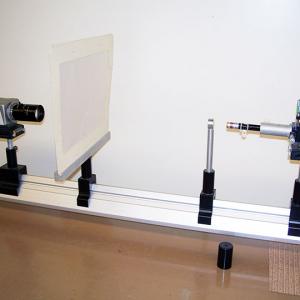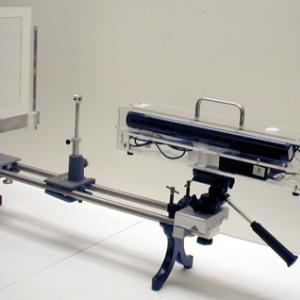College of Liberal Arts & Sciences
6C20.30 - Diffraction - Pinhole
Pinhole diffraction can be demonstrated with the shown apparatus. Projected onto a white screen in a darkened room it can be seen quite well. The #100 pinhole works the best for this.
Note: The 2 axis stage used with the laser pointer makes it very easy to adjust for maximum intensity through the pinhole.
If using a regular laser, the closer the pinhole to the laser the easier it is to adjust.
- V. Anantha Narayanan, "Low‐Cost Diffraction Experiment", TPT, Vol. 34, #6, Sept. 1996, p. 382.
- D. S. Burch, "Fresnel Diffraction by a Circular Aperture", AJP, Vol. 53, #3, Mar. 1985, p. 255.
- Rainer Weiss and Dirk J. Muehlner, "Ultrasimple Demonstration of Fraunhofer Diffraction and Interference", AJP, Vol. 37, #5, May 1969, p. 566.
- Richard E. Berg, "Demo Hints: Laser Diffraction", PIRA Newsletter, Vol. 3, #11, Mar. 31, 1989, p. 3.
- Yaakov Kraftmakher, "4.2. Diffraction of Light", Experiments and Demonstrations in Physics, ISBN 981-256-602-3, p. 227.
- "O-550. Pinhole with Laser", DICK and RAE Physics Demo Notebook, 1993.
- T. Kallard, "Airy's Disc", Exploring Laser Light, p. 191.
- Janice VanCleave, "Diffraction: The Spreading of Light", A+ Projects in Astronomy, p. 43.
- Janice VanCleave, "Spreader", Help, My Science Project is Due Tomorrow, p. 94.
- Robert Ehrlich, "Q.12. Pin Holes in Aluminum Foil", Turning the World Inside Out and 174 Other Simple Physics Demonstrations, p. 204 - 205.
- C. Harvey Palmer, "Experiment B18: Demonstration of the Illumination in the Airy Disk", Optics - Experiments and Demonstrations, John Hopkins Press, 1962.
Disclaimer: These demonstrations are provided only for illustrative use by persons affiliated with The University of Iowa and only under the direction of a trained instructor or physicist. The University of Iowa is not responsible for demonstrations performed by those using their own equipment or who choose to use this reference material for their own purpose. The demonstrations included here are within the public domain and can be found in materials contained in libraries, bookstores, and through electronic sources. Performing all or any portion of any of these demonstrations, with or without revisions not depicted here entails inherent risks. These risks include, without limitation, bodily injury (and possibly death), including risks to health that may be temporary or permanent and that may exacerbate a pre-existing medical condition; and property loss or damage. Anyone performing any part of these demonstrations, even with revisions, knowingly and voluntarily assumes all risks associated with them.


